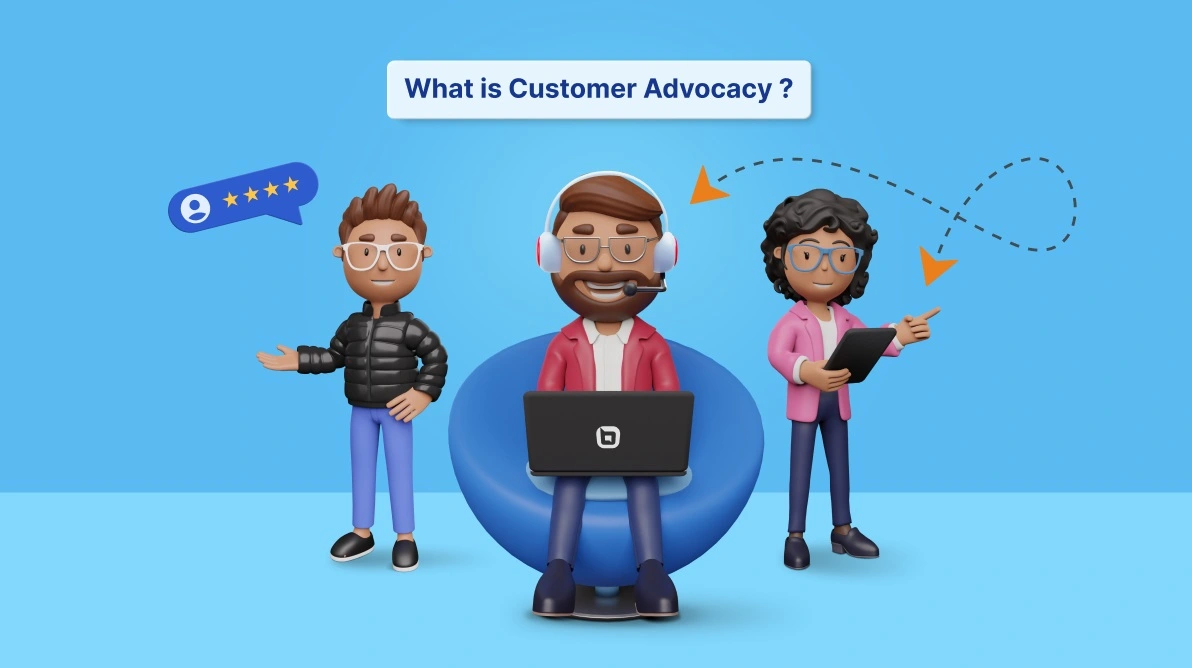Having happy and satisfied customers is vital to the success of businesses.
Going the extra mile to ensure you offer an outstanding customer experience is often rewarded by customer advocacy from regular customers who become loyal, vocal supporters of your business.
A survey conducted by KMPG found that 86% of loyal customers are likely to recommend a brand to family and friends.
This clearly demonstrates the power of having a robust network of loyal clients who can act as an extension of your customer service and sales teams, providing special perspectives and experiences that help both your business and other clients.
Now, the question arises: how can you improve customer advocacy? Don’t worry, we have a comprehensive guide for you in this article, covering various topics related to customer advocacy.
What is customer advocacy?
Customer advocacy is when satisfied customers actively support and promote an organization through positive feedback and recommendations.
It often occurs through word-of-mouth, online reviews, and social media sharing. This kind of promotion helps build trust and attract new customers to the business.
To maximize its impact, businesses can provide more opportunities for customers to engage and advocate, ultimately leading to higher levels of customer satisfaction.
Who is a customer advocate?
A customer advocate is a person who willingly shares their positive brand experience with others.
Their advocacy stems from exceptional interactions with the brand, such as high-quality products or outstanding customer service.
Building an effective customer advocacy strategy
Organizations should aim to understand what motivates most loyal customers to support and promote a brand.
Here are some strategies that can help brands enhance their customer advocacy.
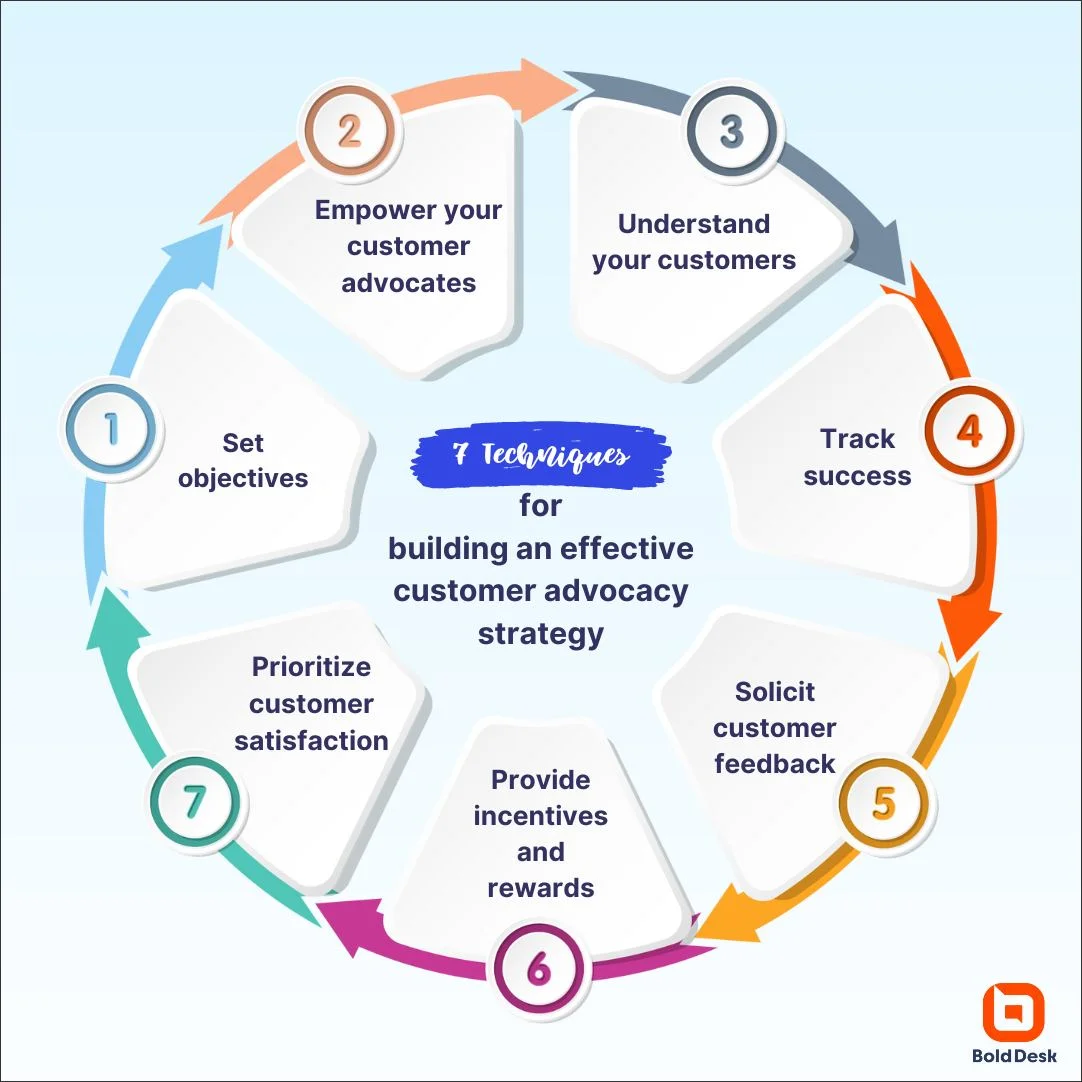
1. Set an objective for your customer advocacy program
Establish your advocacy program’s goal, be it raising brand awareness, increasing revenue, or something else entirely.
- Ensure that your goals and vision can be a result of your consumer advocacy strategy.
- Make sure everyone in the organization understands your customer advocacy vision and how it will benefit every side of the business.
- Outline the steps required to put strategic advocacy priorities into practice and lay out the ways success will be measured.
This thorough planning will make it possible to evaluate advocacy campaigns.
2. Empower your customer advocates’ voices
A customer advocacy strategy centers on empowering customers by giving them the tools, resources, and platforms to share authentic experiences and shape the brand’s reputation.
Additionally, organizations can share content like video tutorials, feature client insights in webinars and highlight testimonials to amplify the advocates’ voices.
Through empowering their customers, brands can build a devoted following that not only supports the business but also acts as a catalyst for marketing its goods and services.
3. Understand your customers
Consider your customers’ goals and interests if you want to convert them into brand ambassadors.
This may involve engaging with them regularly, showcasing the value of products rather than just features, and evaluating customer service quality.
Additionally, your customer-facing teams can practice customer service empathy to ensure you understand clients’ feelings and emotions.
4. Track success and promote stories of customer achievements
Businesses can measure the success of their customer advocacy goals through tracking metrics, such as revenue, win rate, social media interactions, net promoter score, and customer feedback.
Analyzing these metrics before and after implementation helps identify progress and areas for improvement.
Additionally, highlighting customer success stories through authentic testimonials and case studies across various platforms builds brand credibility and inspires others to become advocates.
5. Seek feedback to enhance support operations
Customer feedback is more than just opinions, it’s the blueprint for building smarter and more responsive support operations.
Businesses can actively seek customer feedback through surveys, social media, and focus groups to identify pain points and improve service quality.
The client feedback can also be used to train the customer support team on client needs and expectations to ensure a better service delivery and customer happiness.
6. Provide incentives and loyalty programs
Setting up customer loyalty programs and incentives is an effective strategy for improving customer advocacy.
Brands can provide incentives such as rewards, exclusive deals, first access priority and referral bonuses to make participation appealing and worthwhile.
Using referral programs encourage customers to promote your brand by rewarding them for successful recommendations.
7. Prioritize customers’ satisfaction and enhance their experiences
Delivering exceptional experiences begins with making customer satisfaction a top priority at every stage of the customer journey.
Companies can achieve this by consistently exceeding expectations, responding quickly to customer needs, personalizing interactions and implementing customer suggestions to show genuine commitment to improvement.
When every touchpoint is optimized for satisfaction, customers are more likely to become loyal supporters who refer your business’s products or services to their colleagues and friends.
Why is customer advocacy important?
Implementing a fruitful customer advocacy approach is one of the most economical methods to expand your business. Here are some of its significant advantages.
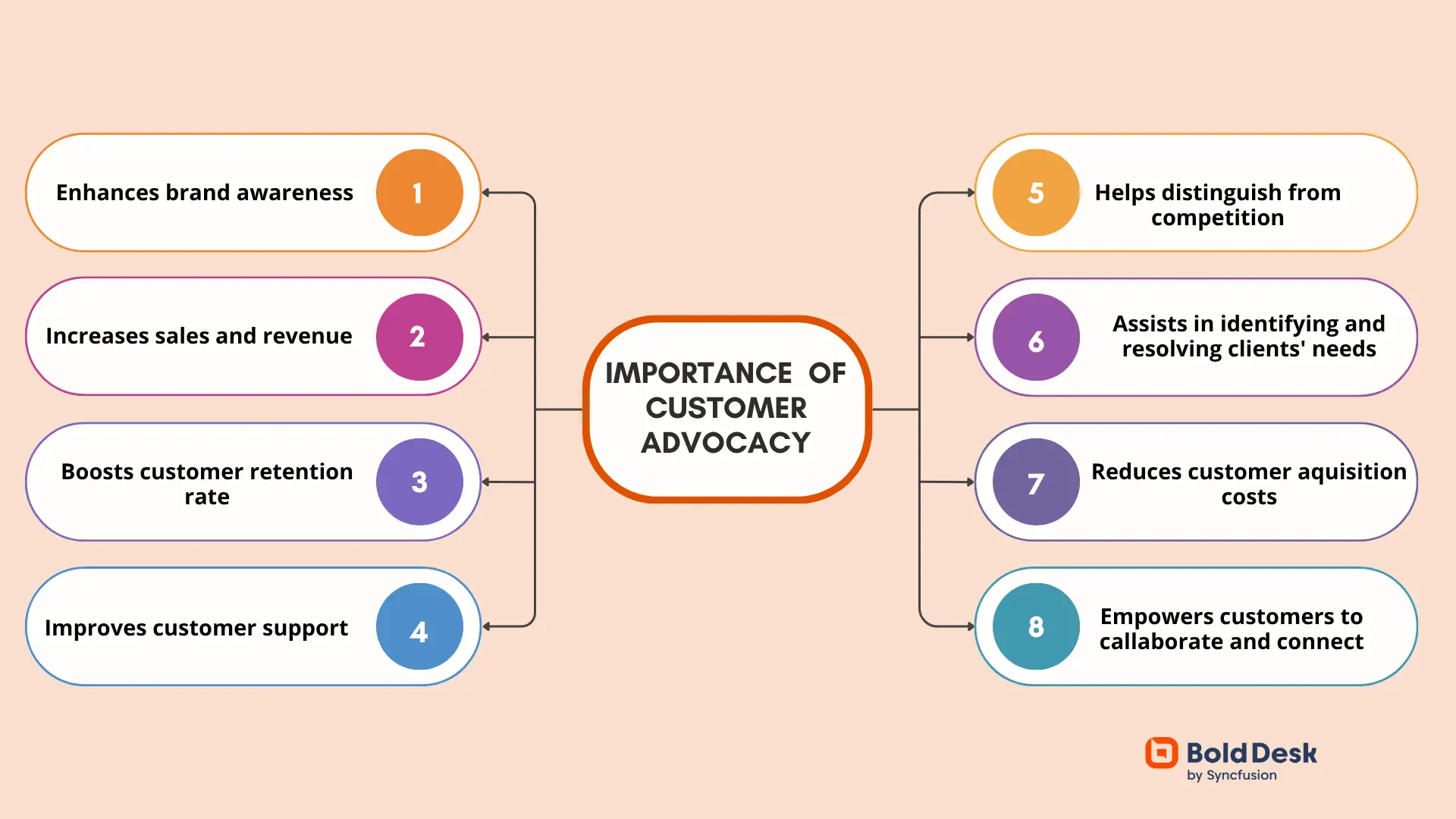
Enhances brand awareness
Customer advocates share their experiences publicly through creating user-generated content, such as reviews or social media posts.
This organic visibility through personal networks and online platforms increases recognition and familiarity among potential buyers.
Increases sales and business revenue
Referrals from advocates drive higher conversion rates by influencing purchase decisions more effectively than traditional marketing.
Statistics from the National Retail Federation show that 43% of customers spend money on brands they’re loyal to.
Additionally, advocates often attract new audiences by amplifying brand credibility, leading to expanded market reach and increased purchase activity.
Boosts customer retention rate
Positive testimonials from advocates reinforce trust and encourage others to stay loyal to your brand.
When customers feel valued and their needs and expectations are consistently met, they are more likely to stay with the company, reducing churn and boosting long-term relationships.
Improves customer support through facilitating self-service
A study by Harvard Business Review showed that 81% of customers, regardless of the type of business, try to resolve their problems on their own before contacting a live agent.
Therefore, brands should encourage advocates to share helpful tips, solutions, and product knowledge in public forums, communities, or social media, which can be used to create searchable resources that helps others to solve issues independently.
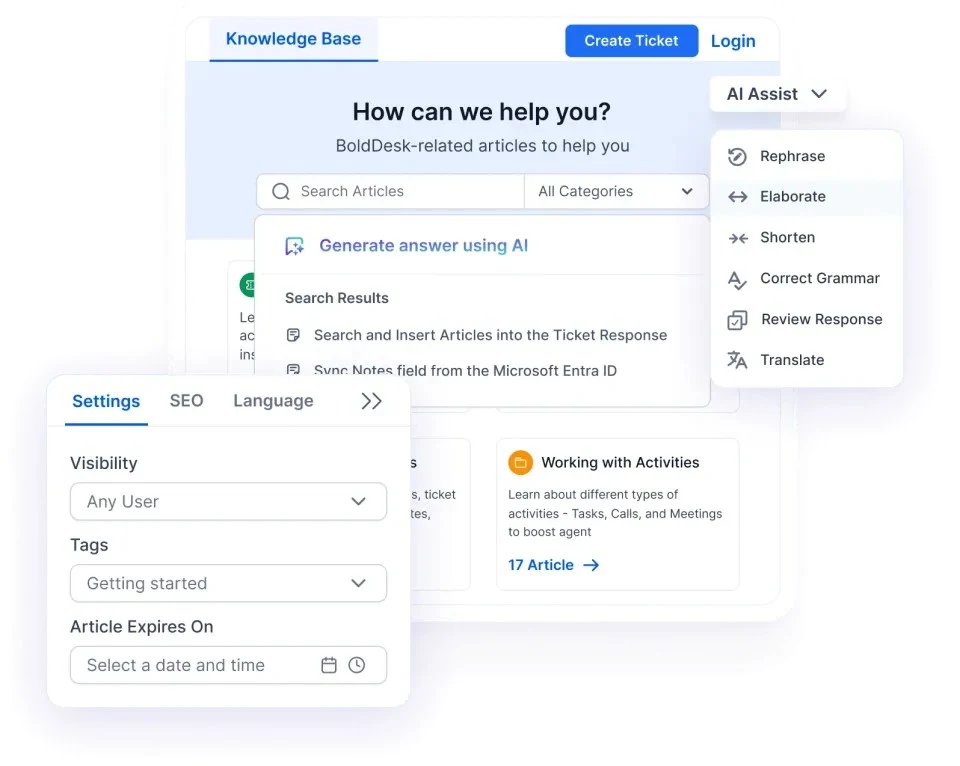
Companies can also identify frequently shared solutions and incorporate them into official self-service tools like FAQs, knowledge bases or help centers.
Helps distinguish you from the competition
When advocates share specific use cases, success stories, or personal outcomes, it creates a differentiated narrative that competitors may not be able to replicate.
This personalized storytelling builds a distinct identity around the brand, making it stand out in the market.
Assists in proactively identifying and resolving customer needs
Advocates’ feedback helps companies spot trends and address issues before they escalate. Their insights guide product development and customer experience improvements.
This proactive approach keeps your brand ahead of evolving customer expectations.
Significantly reduces customer acquisition costs
Customer advocates promote your brand voluntarily, which helps reduce the need for expensive marketing campaigns.
Recommendations from these advocates carry more weight than paid advertisements, making it a cost-effective strategy for businesses to attract new clients.
Empowers customers to connect and collaborate
Clients can easily engage with each other through forums, social media groups, and brand-hosted platforms, where they share experiences, advice, and support.
Brands can facilitate this by spotlighting advocates, organizing events, or creating spaces where customers can collaborate and contribute.
Metrics to measure customer advocacy success
Here are some key ways to measure the effectiveness of customer advocacy:
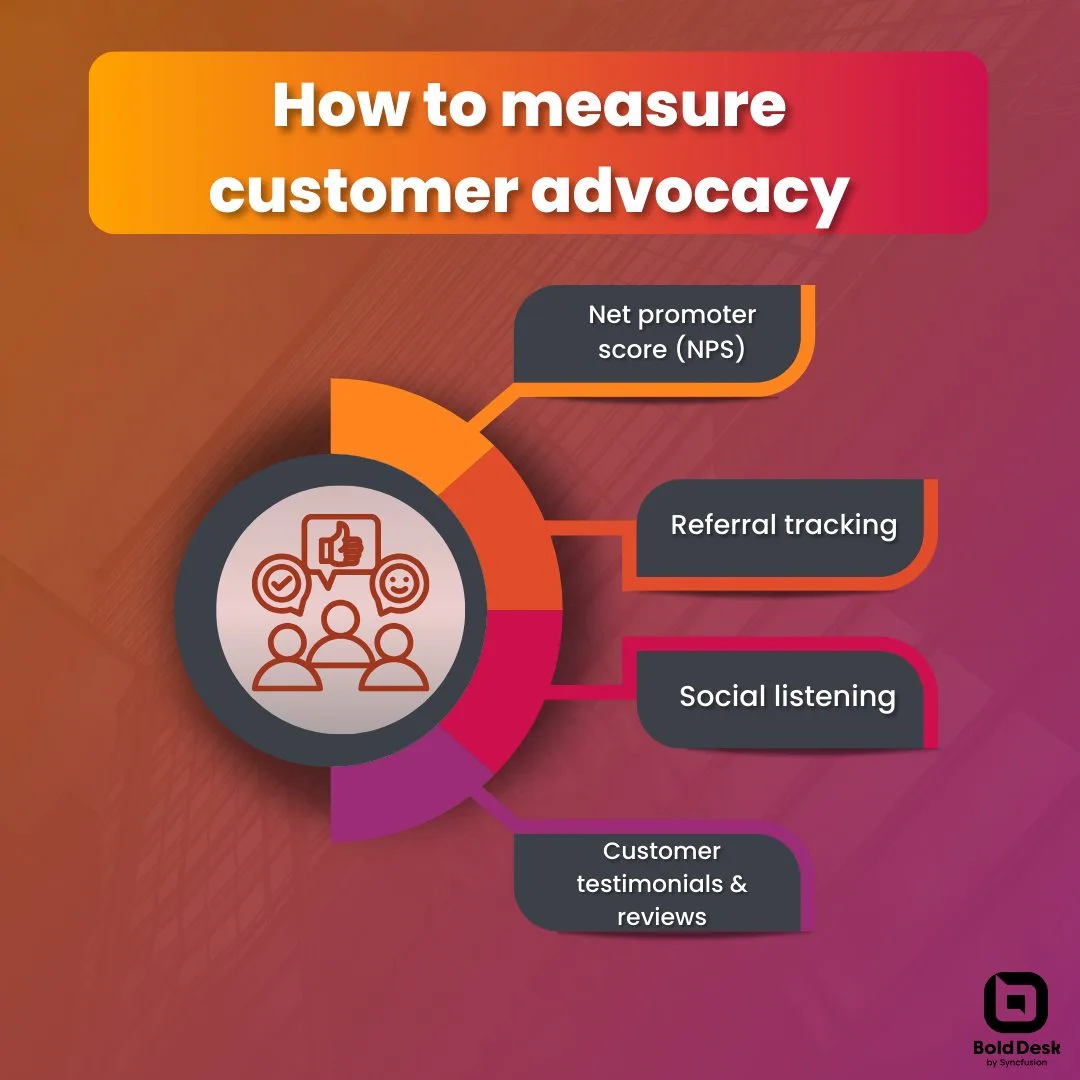
Net promoter score (NPS)
Net promoter score is measured by asking customers how likely they are to recommend a company/product/service to a friend or colleague on a scale from 0 to 10.
Based on their responses, customers are categorized as Promoters (9–10), Passives (7–8), or Detractors (0–6).

The net promoter score formula involves subtracting the percentage of Detractors from the percentage of Promoters.
Referral tracking
One effective way to measure customer advocacy is by implementing referral tracking, which captures how frequently customers recommend a brand to others.
This is typically done using unique links, codes, or dedicated platforms that link new purchases back to the original advocate.
The resulting data, such as referral volume, conversion rates, and repeat referrals provides a clear indication of advocacy strength and customer engagement.
Social listening
Monitoring online conversations, mentions, and perception about your brand across platforms like social media, forums, and review sites.
It involves using tools to track keywords, hashtags, and brand names to identify how often and in what context customers speak positively or negatively.
The collected data is analyzed to gauge the level of organic support and influence customers exert in public digital spaces.
Customer testimonials and reviews
More client reviews, evaluations, and testimonials are a direct benefit of consumer advocacy.
In addition to the number of reviews, the rate at which new reviews or evaluations are accumulated is an indicator of how successful your customer advocacy efforts are.
Beyond the raw number of reviews, businesses can examine customer sentiment and monitor trends or changes that may need to be made overtime.
Make customer advocacy your best marketing strategy
Creating great client experiences builds a community of devoted brand advocates that helps spread the word about your brand and company.
Making customer advocacy a pillar of your marketing strategy will result in high-quality referrals from loyal, satisfied customers.
If you’re aiming to enhance and deliver exceptional client experiences, BoldDesk can play a vital role in driving a successful customer advocacy program.
You can reach out to the support team if you have any questions about its capabilities.
Have thoughts, questions, or feedback about customer advocacy? Leave a comment in the spaces provided below.
Related articles
- How to Measure and Improve the Customer Service ROI
- Customer-Centric Business – The Complete Details
- SMART Customer Service Goals: A Guide to Setting and Achieving Them
FAQs on Customer Advocacy
Enhancing customer advocacy begins with consistently delivering exceptional customer experiences and building strong, trust-based relationships.
To keep advocates engaged and motivated, consider implementing loyalty programs, actively encouraging feedback, and recognizing those who champion your brand.
These efforts help transform satisfied customers into loyal advocates who promote your business organically.
Customer advocacy involves actual customers who promote a brand based on their personal experiences and satisfaction with its products or services.
On the other hand, brand advocacy can include anyone who supports a brand, such as employees, influencers or partners, even if they haven’t used the product directly.
Yes, when handled well, a negative experience can become a powerful loyalty driver.
By resolving the issue quickly, showing empathy, and going above and beyond to make things right, you can turn frustration into trust and advocacy.
A customer advocacy program is a structured initiative implemented by a business to foster and cultivate a positive relationship with its customers.
Common forms of customer advocacy programs include referral programs, testimonials, case studies, online reviews, rating outreach, social media advocacy outreach, and customer success stories.
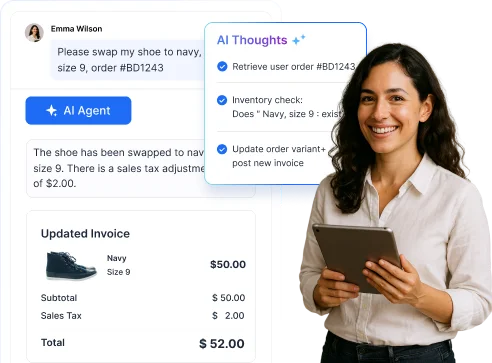


















 Email Ticketing System
Email Ticketing System Shared Inbox Software
Shared Inbox Software Multi Brand Help Desk
Multi Brand Help Desk Internal Help Desk Software
Internal Help Desk Software Trouble Ticketing Software
Trouble Ticketing Software Mobile Help Desk
Mobile Help Desk 










